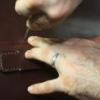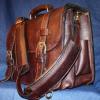-
Posts
2,258 -
Joined
-
Last visited
Content Type
Profiles
Forums
Events
Blogs
Gallery
Everything posted by esantoro
-
Is it possible to thin simply with water? I've also got some pretty thick gum trag. ed
-

handheld belt sander or planer for reducing 10 oz veg tanned to 6 oz
esantoro replied to esantoro's topic in Leather Tools
Randy, I was thinking that there were two types of electric sanders, a circular one which spins around and an orbital one which gyrates. For one project, I would be thinning three 17" x 12" pieces of 10 oz veg tan, one 17" x 26" piece, and two 5" x 42" pieces, with odds and ends. I'll pick up the highest powered variable speed orbital sander I can get and give it a try. With the right grit and pressure everything should be controllable. I'll post pictures. Thanks, Ed -
Bruce, I was actually thinking of using it on the ground underneath my workbench and was hoping the splitter alone would weigh in at no more than 200lbs. Last time I talked with Artisan I was told the whole setup weighs about 450 lbs. But if what you say is true about the motor being a necessity, especially for 17"-wide leather, I should hold out until I have the real space for it. I'm going to home depot tomorrow to pick up a handheld electronic planer for wood to experiment with and will return it if it's not feasible. ed
-

handheld belt sander or planer for reducing 10 oz veg tanned to 6 oz
esantoro replied to esantoro's topic in Leather Tools
Hi Randy, Thanks for the heads-up on the belt sander. What do you think about a circular sander or a gyrating sander?. I've noticed that sanding by hand can take down a 2" square section from 4 mm to about 3.8mm in 30 seconds or so. Since an hour of manual sanding can get rather tiring, I was thinking a circular or gyrating sander might be plan B. I think at either Lowes or Home Depot I can try out these tools and return them if they don't work as needed. Ed -
Just came up with a new idea. How well would this splitter work freestanding by hand, no motor and not attached to the table? I've got some space underneath my work bench that could fit the splitter. I'll call Artisan to find out more, but how heavy would you say the standalone splitter is, without the table? Ed
-
How well would a handheld electronic planer work at thinning down vegetable tanned leather? Ed
-
Weaver sells that one. I wish its catalog would have shown those same angles. What kind of a woodworking tool would one need to carve that kind of a groove? Router? I was thinking of cutting off about 3" of some turning stock and doing something similar. Ed
-
Happened to find myself in Sears today and came upon handheld belt sanders and planers that you move along the surface of your object. How well might either of these work for reducing 10 oz vegetable tanned leather to 6 oz? Which would work better, the sander or the planer. For $100 this just might be the ticket. Thanks, Ed
-
Valerie Michael in her wonderful book suggests diluted paper gum, which I'd like to find. Ed
-

Use it up, wear it out, make it do or do without!
esantoro replied to Johanna's topic in Leatherwork Conversation
Coffee, jelly, and peanut butter jars come in handy for dyes and glues. I tape the outside with masking tape to keep as much light out as possible. The lids to these are also very useful for holding miniclips with felt for dying and beads of glue for when I just need to dab a bit of glue into tight places with a toothpick. -
Strange. Just as I sent off this post, I looked up and there it was, an empty 35mm film canister: 30mm in diameter. Please let me know if you find other objects. Ed
-
I need a round object with a diameter of 30mm to 32mm to use as a cutting template. If you happen to stumble across anything that fits the bill will you let me know? I think I'll head to the supermarket tomorrow with my calipers. Seriously. Thanks, Ed
-
Weaver has an LCI product called Tuff Cote (comes in clear and black, which I've read can also be used as an edge finish), which has a satiny finish. Here's some information From the DYO site for a similar glossy-finish product: Top Cote # 9: Top Cote # 9 is the most durable clear top cote currently available. Top Cote # 9 offers excellent adherence, flexibility and stands side by side with DYO Tuff Cote in terms of abrasion, scuff, and impact resistance. Top Cote # 9 provides a high gloss and is water based. The intense gloss achieved with Top Cote # 9 makes it the perfect top cote for exotic leathers such as alligator, ostrich, and lizard. Application: Spray or Manual I'm putting in an order first of the year for the Tuff Cote and a waterproofing Top Coat #200: A solvent-system, semi-gloss, waterproof/protective coating. Excellent adhesion and flexibility. Spray application. If thinning is desired, use LCi Thinner only. Ed
-
Hi Keith, Thanks for this update. Would you say that the Artisan 20" could split a 17" x 26" inch piece of 9/10 oz. bridle down to 5/6 oz without any problem? One pass? Two at the most? Regards, Ed
-
I haven't standardized my bag flap lengths and shapes, as I like to see how each bag behaves before shaping and stitching the flap. It is the last part I do on each bag. I did get two wonderful folding adjustable tables that work nicely, but part of the way into stitching the flap, I find that it would be nice to be able adjust the height of the table to make manipulation of the bag easier. I have modified the procedure somewhat to make it easier, but I still like the idea of having some kind of suspension device onto which I can put three hooks or whatever that allow for three different suspension points, which would allow for easy manipulation of the bag in the middle of stitching. Once I find a way to clamp a pole horizontally above the machine, I'll be 90 percent there and can experiment at will with cord, bungee cord, whatever, for the actual suspension. Allright. Nuff said. I'm off to the corner hardware store. Ed
-
I need to devise a method for clamping a pole or rod to extend above my stitching machine and from which I can suspend certain articles I'm working on so that I can free up both of my hands to guide the article through the machine. I'd need this assembly to be able to support 15 lbs with additional tugging and pulling. I've attached a picture that shows the rails of my storage rack, to which I would like to attach a pole or rod. So far I'm thinking that I could use some kind of T-clamp. Any other ideas? Thanks, Ed









